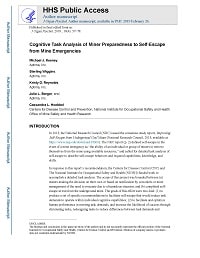Mining Publication: Cognitive Task Analysis of Miner Preparedness to Self-Escape from Mine Emergencies
Original creation date: November 2018
Authors: MJ Keeney, S Wiggins, KD Reynolds, JL Berger, C Hoebbel
In 2013, the National Research Council (NRC) issued the consensus study report, Improving Self-Escape from Underground Coal Mines (National Research Council, 2013; available at https://www.nap.edu/login.php?record_id=18300). The NRC report (p. 2) defined self-escape in the event of a mine emergency as “the ability of an individual or group of miners to remove themselves from the mine using available resources,” and called for detailed task analysis of self-escape to describe self-escape behaviors and required capabilities, knowledge, and skills.
In response to this report’s recommendation, the Centers for Disease Control (CDC) and The National Institute for Occupational Safety and Health (NIOSH) funded work to accomplish a detailed task analysis. The scope of this project was bounded between (a) miners making the decision on their own or based on notification by coworkers or mine management of the need to evacuate due to a hazardous situation, and (b) completed self-escape at exit from the underground mine. The goals of this effort were two-fold: (1) to produce a set of specific recommendations to facilitate self-escape that would reduce task demands to operate within individual cognitive capabilities; (2) to facilitate and optimize human performance in meeting task demands, and increase the likelihood of success through eliminating tasks, redesigning tasks to reduce differences between task demands and individual capability, or improving human performance through better training and/or assistive tools and technology.
The project consisted of four phases, and the current paper focuses on the cognitive task analysis (CTA) work done in Phase 4. During Phase 1, we developed data collection protocol and materials and secured NIOSH Institutional Review Board approval and clearance from the U.S. Office of Management and Budget (OMB), which is required to collect data from persons outside the government. In Phase 2, we identified self-escape tasks, organized them into categories, and identified which tasks are critical to successful escape. In Phase 3, we performed hierarchical task analysis recommendations development. Finally, in Phase 4, we performed a CTA to describe thought-based components of escape, particularly information sharing, goal setting, planning, and decision-making, and developed results-based recommendations.

- Behavioral and Organizational Dimensions of Underground Mine Fires
- Decision Making During a Simulated Mine Fire Escape
- Emergency Escape and Refuge Alternatives
- An Examination of Antecedents to Coal Miners' Hearing Protection Behaviors: A Test of the Theory of Planned Behavior
- Harry's Hard Choices: Mine Refuge Chamber Training
- Job Design: An Effective Strategy for Reducing Back Injuries
- Job Training Analysis: A Process for Quickly Developing a Roadmap for Teaching and Evaluating Job Skills
- Self-Escape from Underground Coal Mines Training Initiative
- Task Analysis
- When Do You Take Refuge? Decisionmaking During Mine Emergency Escape